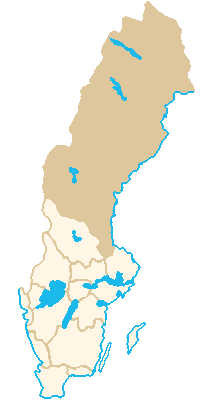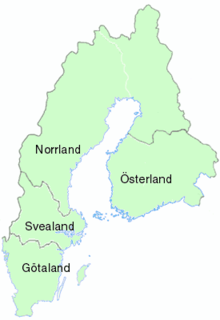Norrland
Norrland is the northernmost of today's three Swedish regions ( landsdelar ) Götaland , Norrland and Svealand . It comprises the nine historical provinces, also known as "landscapes" (Swedish landskap ), Lapland , Norrbotten , Västerbotten , Ångermanland , Medelpad , Gästrikland , Hälsingland , Härjedalen and Jämtland . With an area of 261,292 km², Norrland makes up about 59 percent of Sweden's total area. With 1,116,000 inhabitants or only 12.8 percent of the total population, the area is sparsely populated.
In today's Sweden, the division into parts of the country is of marginal interest. It is mainly used in meteorology and in summary statistics , whereby Norrland is often divided into Övre Norrland ( Norrbottens län and Västerbottens län ) and Nedre Norrland ( Jämtlands län , Västernorrlands län and Gävleborgs län ) due to the area . As the NUTS 1 region Norra Sverige (SE3), the term “Northern Sweden” is seen a little more broadly.
history
Norrland was populated soon after the ice sheet melted about 10,000 years ago. The “ slate culture” developed there in the younger Stone Age . Proto-Sami traditions developed in the Bronze Age .
Little is known from the pre-Christian times. The place names indicate that Frey and Freyja as well as Thor had places of worship here. Even Odin and Ull are represented. The place names on -hov, -vi, -vall, -åker and other endings indicate pre-Christian places of worship. Some of them seem to have had supra-local importance.
The so-called Frösöstein , a rune stone to commemorate the construction of a bridge, is evidence of Christianization . There it says: "Östman Gudfastson had this stone built and built this bridge, and he Christianized Jämtland." It is dated to the second half of the 11th century. How this Christianization took place can no longer be determined. When King Sverre traveled through southern Norrland with his birch legs in a campaign against Trøndelag in 1178 , this was already Christianized after the Sverres saga. This is countered by other written documents that note for the period between 1220 and 1240 that no one in Ström , (northern Jämtland) could use the Our Father. And from a letter from Archbishop Peter from the end of the 12th century, it appears that the conversion took place only recently. From these contradicting sources, it is concluded that Christianity gradually spread in southern and central Norrland in the 10th, 11th and 12th centuries, but that organized church formation can only be spoken of in the 13th century. The prevailing opinion assumes that the Christianization originated in Norway and England. Others conclude from the fact that the Frösöstein is a Swedish and not a Norwegian rune stone and its ornamentation resembles that from the Mälar area and that Jämtland belonged to the Archdiocese of Uppsala from the start , although it was politically part of Norway at the time, that Christianization was more of southern Sweden ran out of. It is also considered that the alternative does not do justice to the times, because Jämtland at that time was largely independent and exposed to influences from the west, south and possibly also from the east.
It was not until 1435 that the term “Norrland” appeared in the rhymed so-called “Karlschronik” from the Union period.
Norrland's historic southern border in today's Sweden is Ödmården , a large forest area between Gästrikland and Hälsingland. Gästrikland used to belong to Svealand and has only been part of Norrland in the last few centuries.
Until 1809, the northern part of today's Finland also belonged to Norrland, which was then ceded to Russia . The border between what was then Österland and Norrland was formed by the river Oulujoki (Swedish Ule älv ), which flows into the Gulf of Bothnia near the city of Oulu (Swedish Uleåborg ) .
economy
Norrland is particularly known for its nature. Here you will find enormous forests, large rivers and still untouched wilderness. In the 19th century it became the source for Sweden's important wood and pulp industries. With four exceptions, the Norrland rivers are used to generate hydropower and generate around 40 percent of all Swedish energy needs.
Norrland is extraordinarily rich in natural resources, which have been of enormous importance to the development of Swedish industry. In the mines iron ore is extracted for the production of steel , but also gold , silver and other metals.
nature
The highest mountain in Sweden at 2,104 meters, Kebnekaise , is located in Lapland in northern Norrland.
The southern border of Norrland coincides roughly with the limes norrlandicus , which describes a profound transition in the vegetation structure. The interior consists largely of forest and mountain landscapes .
The northernmost rivers (from the north): Torne älv , Kalixälven , Lule älv , Piteälven , Skellefte älv , Ume älv .
literature
- Stefan Brink: När norrlänningen bytte religion. In: Helgonet i Nidaros. Olavskult och Kristnande in the north. o. O. (1997). Pp. 240-252.
- Norrland . In: Theodor Westrin (Ed.): Nordisk familjebok konversationslexikon och realencyklopedi . 2nd Edition. tape 19 : Mykenai-Norrpada . Nordisk familjeboks förlag, Stockholm 1913, Sp. 1490 (Swedish, runeberg.org ).

